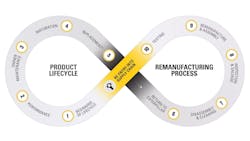Caterpillar, ABB, L3Harris: How Industry Leaders Are Scaling Sustainability
Manufacturers looking to scale their sustainability strategies need not start from scratch. Companies have numerous technical and digital programs already in place that can significantly contribute to ESG targets and impact customers' carbon footprints.
However, many companies fail to conduct a thorough inventory of these existing programs, missing opportunities to include them in their sustainability scope and reports. To address this, technical, digital, and sustainability teams need to collaborate and rework the value propositions of current digital and technical initiatives with a sustainability focus.
I suggest starting with four key areas. Many industrial companies have undertaken digital transformations over the past decade, launching initiatives related to predictive maintenance, IoT, product-as-a-service, and servitization.
Here’s an analysis of how initiatives in each of these areas contributes to sustainability programs and their impact:
1. Managing Your Installed Base
This refers to the systematic oversight and maintenance of a company's existing equipment and systems to ensure they operate efficiently and effectively. It involves regular monitoring, servicing and upgrading to extend the lifespan of assets by providing spare parts, repair, and remanufacturing service. Here is the Caterpillar example in the remanufacturing area: Caterpillar | Remanufacturing Process).
Sustainability Contribution:
By effectively managing existing installations, companies can ensure that equipment and systems are running at peak efficiency, reducing unnecessary energy consumption and extending the life of products. Additionally, proper maintenance and upgrades can prevent premature obsolescence and reduce the amount of electronic waste.
Impact:
Environmental: Lower energy use and reduced waste generation decrease the overall environmental footprint.
Economical: Prolonging the life of existing assets can lead to cost savings and improved return on investment.
Social: Enhanced reliability and performance of systems can lead to higher customer satisfaction and trust in the brand.
2. Developing As-a-Service Models
Implementing as-a-service models transforms the traditional ownership model into one where customers pay for access to products or services on a subscription or pay-per-use basis. Read more about backup generator manufacturer Generac’s resiliency-as-a-service model: Resiliency as a Service - Generac Grid Services (generacgs.com)
Sustainability Contribution:
As-a-service models often emphasize the efficient use of resources by providing access rather than ownership, which can lead to better utilization rates. These models allow for scalable and flexible solutions that can be adjusted to actual needs, reducing overproduction and waste.
Impact:
Environmental: Reduces the need for constant production and disposal of products, leading to lower carbon emissions and resource consumption.
Economic: Creates a steady revenue stream and reduces the financial burden on customers, promoting more sustainable consumption patterns.
Social: Increases accessibility to advanced technologies and services, supporting broader economic and social inclusion.
3. Launching IoT Solutions
Implementing industrial IoT solutions involves deploying connected sensors and devices to monitor and manage industrial operations in real-time. This enhances efficiency, reduces resource consumption, and enables predictive maintenance. Here is an example of IIoT solution managed by ABB: ABB Ability. Industrial Internet of Things
Sustainability Contribution:
IoT solutions enable real-time monitoring and management of resources, leading to more efficient energy use and resource conservation. IoT can predict failures before they occur, reducing downtime and extending the lifespan of equipment.
Impact:
Environmental: Improved efficiency and reduced waste contribute to a smaller environmental footprint.
Economic: Cost savings from energy efficiency and extended equipment life.
Social: Better performance and reliability of services enhance quality of life and safety for consumers.
4. Focusing on Reuse and Selling Second-Hand Products
Prioritizing reuse, repair and the sale of secondhand products involves refurbishing and reselling used items to extend their lifecycle. A good example is the L3Harris Sky Parts Global program (SkyParts Global - Used Serviceable Material | L3Harris Fast. Forward.)
Sustainability Contribution:
These programs promote the circular economy by extending the lifecycle of products. They also reduce the volume of waste sent to landfills.
Impact:
Environmental: Significantly lowers environmental impact by minimizing the need for raw materials and reducing waste.
Economic: Offers affordable alternatives for consumers and opens new revenue streams for businesses.
Social: Encourages sustainable consumption habits and makes quality products accessible to a broader audience.
Together, these initiatives cultivate a more sustainable business model by optimizing resource utilization, minimizing waste and fostering efficient consumption patterns, thus supporting environmental, economic and social sustainability objectives. Their collective impact can significantly enhance materiality.
In our extensive work with leaders in industrial firms, it is evident that many are unaware that these technical and digital programs should be integrated into their sustainability development portfolios. When this integration occurs, the economic value of these programs has already been established and communicated.
The next critical step is to quantify their impact on sustainability goals and demonstrate the benefits they provide to customers in terms of cost savings, waste reduction and carbon footprint reduction. These initiatives are already in place, negating the need for new brainstorming or design efforts. Instead, a focused 60-day sprint with the relevant stakeholders can achieve substantial progress.
About the Author
Stephan Liozu
Chief Value Officer, Zilliant
Stephan Liozu, Ph.D. is chief value officer at Zilliant, a pricing management and optimization software provider. He brings over 20 years of experience in pricing, innovation and value management. An expert in the global pricing landscape, he is the author of over 15 pricing books, including “Pricing—The New CEO Imperative” (2021) and “Value-based Pricing: 12 Lessons to Make Your Transformation Successful” (2024).
